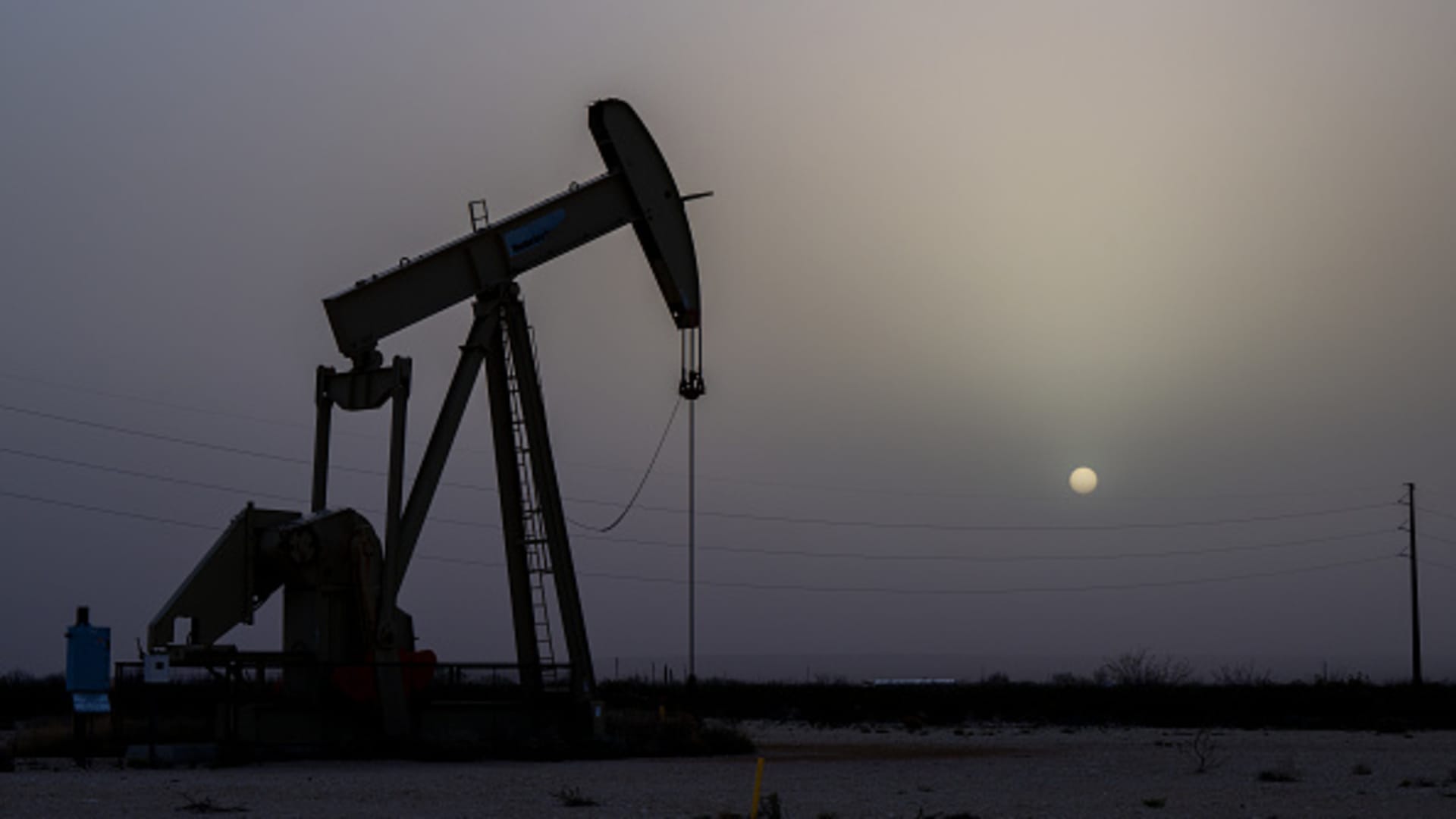Coterra Energy’s second-quarter results beat expectations on the top and bottom lines, sending shares modestly higher Tuesday. Still, the report and conference call weren’t enough for us to warm up to this poorly performing stock. Revenue in the three months ended June 30 totaled $1.97 billion, ahead of the $1.7 billion consensus, according to LSEG. Adjusted earnings per share (EPS) came in at 48 cents, topping estimates by 3 cents, LSEG data showed. Shares of Coterra are up about 0.5% Tuesday, overcoming earlier losses of roughly 2%. The stock entered the session down 6.3% year to date, trailing both the S & P 500’s energy sector and the broader index. It’s become a difficult environment for prices of both natural gas and oil, hurting Coterra in the process. The stock’s fortunes this year turned around the time of President Donald Trump’s April 2 tariff announcement, which sent oil prices tumbling as traders recalibrated their expectations for global economic growth. For its part, Coterra’s poor earnings report in early May, marked by operational issues in some of its Texas acreage, sparked another leg lower for the stock and cast another pall over shares ever since. Bottom line As far as the numbers go, Coterra reported a solid quarter driven by higher-than-expected total production. But when you step back and consider the bigger picture — the downbeat market for oil and gas prices alongside the operational hiccup that Coterra is working through — it’s hard to get too excited about the stock. West Texas Intermediate, the U.S. oil benchmark, has slipped around 5% year to date, while natural gas futures are down even more. We trimmed our position on July 8 when shares traded above $25 apiece, and we continue to view Coterra as a stock to trim into any potential strength. There was a short-lived rally in oil prices above $70 a barrel when the Israel-Iran conflict intensified in June. But when tensions simmered and crude retreated, so did Coterra’s share price. “You can’t outrun your commodity, not if both commodities you’re in are bad,” Jim Cramer said Tuesday. We’re reiterating our 3 rating, meaning sell into strength, and lowering our price target on the stock to $28 a share from $30. Commentary As expected, Coterra provided an update on the excessive water levels afflicting some of the wells it drilled in the Harkey sandstone located in Culberson County, Texas. It’s part of the massive Permian Basin, the most prolific oil field in the U.S., spanning West Texas and eastern New Mexico. CEO Tom Jorden said some of the design changes that Coterra implemented are working and the water issue appears localized rather than widespread across its Culberson County land. Indeed, new wells drilled in the Harkey nearby the problematic ones are producing without issue, Jorden said. Nevertheless, the remedied Harkey wells are still not producing meaningful oil volumes, and Jorden said Coterra is being “very conservative” in its production forecast for them. “We are full steam ahead on Harkey and really do look forward to getting this problem behind us,” the CEO said. Across its entire Permian portfolio, Coterra said it still intends keep nine rigs running this year — in line with its late June update to investors when it walked back plans to drop down to seven. Additionally, Coterra is standing by its previously announced plans to run two rigs in the natural gas-focused Marcellus Shale in Pennsylvania, as well as one to two rigs in Oklahoma’s Anadarko Basin. Coterra’s desire to maintain consistent activity levels stands in contrast to national trends, with rig counts across the U.S. trending down, according to weekly data from oilfield services provider Baker Hughes . Jorden defended Coterra’s approach on the conference call with investors, emphasizing that is has “deep inventory of low-cost assets.” He added, “Our long-term goal … isn’t production. It’s generating free cash flow and demonstrating to the market that we have durability there. One of the things that our asset complexion and our mixture gives us the luxury of is having stable cash flow and having the ability to ride through the cycles.” One interesting nugget in Coterra’s earnings release: The company struck a natural gas supply agreement with a forthcoming power plant — the CPV Basin Ranch Energy Center — being built in the Permian Basin. The seven-year deal to sell 50 million standard cubic feet (MMcf) worth of natural gas per day is slated to begin in 2028. Coterra said this is its first supply agreement in the Permian. It has two such deals in the Marcellus. Analysts at Mizuho Securities said in note to clients that Coterra’s Permian deal could be a “potentially attractive opportunity” to increase the amount of money it makes on gas produced in that region. These types of deals usually include an agreed-upon price that is different than the market price, which in this case would the Waha Hub in West Texas. “We’re really thrilled to have it from a pricing standpoint,” Jorden said, though he noted that it another benefit is Coterra will receive the ability to also buy power from the plant once it’s online. “And availability of power is a growing concern in the Permian Basin, so that really ticks both those boxes.” A side note: Fellow Club name GE Vernova, which makes the gas turbines used to generate electricity, is involved with the development of the Basin Ranch project. GE Vernova has seen a surge in orders for its turbines thanks to the boom in AI-focused data center construction and the related uptick in electricity consumption. The Texas market, in particular, is expected to see “rapid” electricity demand growth, according to the U.S. Energy Information Administration . 2025 guidance Coterra updated some parts of its full-year guidance. All estimates are from FactSet. Capex of $2.3 billion, which would be at the high end of its new $2.1 billion to $2.3 billion range. Its previous guidance issued in May called for $2 billion to $2.3 billion, or $2.15 billion at the midpoint. Free cash flow of roughly $2.1 billion, down from its prior projection of $2.7 billion. However, the revised figure still came in modestly above Wall Street expectations. Total equivalent production of 755 to 780 Mboe/d. The midpoint of the range is 768 Mboe/d, up 3.8% from previous guidance and ahead of the 752.7 Mboe/d consensus.Mboe/d stands for thousand barrels of oil equivalent per day. Natural gas production in the range of 2,875 to 2,950 MMcf/d, resulting in a midpoint of 2,913, which is up about 5% from the previous guidance and matches the Street consensus. Oil production in the range of 157 to 163 Mbo/d. The midpoint of 160 is unchanged from its prior forecast and in line with consensus. (Jim Cramer’s Charitable Trust is long CTRA and GEV. See here for a full list of the stocks.) As a subscriber to the CNBC Investing Club with Jim Cramer, you will receive a trade alert before Jim makes a trade. Jim waits 45 minutes after sending a trade alert before buying or selling a stock in his charitable trust’s portfolio. If Jim has talked about a stock on CNBC TV, he waits 72 hours after issuing the trade alert before executing the trade. THE ABOVE INVESTING CLUB INFORMATION IS SUBJECT TO OUR TERMS AND CONDITIONS AND PRIVACY POLICY , TOGETHER WITH OUR DISCLAIMER . NO FIDUCIARY OBLIGATION OR DUTY EXISTS, OR IS CREATED, BY VIRTUE OF YOUR RECEIPT OF ANY INFORMATION PROVIDED IN CONNECTION WITH THE INVESTING CLUB. NO SPECIFIC OUTCOME OR PROFIT IS GUARANTEED.





